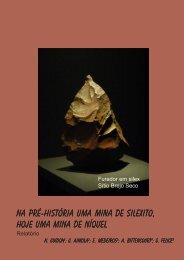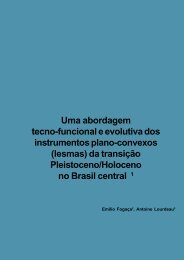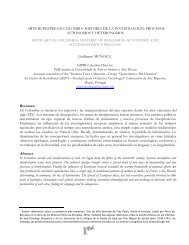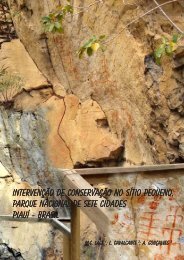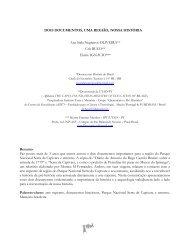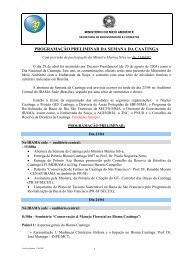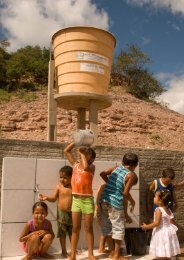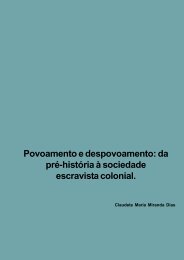Untitled - Fundação Museu do Homem Americano
Untitled - Fundação Museu do Homem Americano
Untitled - Fundação Museu do Homem Americano
Create successful ePaper yourself
Turn your PDF publications into a flip-book with our unique Google optimized e-Paper software.
Global Rock Art Congress<br />
29 Junho – 3 de Julho 2009<br />
Rock Art Recording, What Happens Next: Examples from the USA Northwestern Plains<br />
Mavis Greer & John Greer - Esta<strong>do</strong>s Uni<strong>do</strong>s da América<br />
Recording is expected to serve as a baseline for monitoring change during preparation and implementation<br />
of a management plan, but what actually happens to sites after recording is unpredictable. At the Dangling<br />
Legs site in Wyoming, for instance, the land managing agency ignored available information and permitted<br />
drilling in front of the rockshelter that caused both visual and physical impact. At the Benjamin Hill site<br />
in Montana recording records were lost in State files, and the site was not considered by subsequent<br />
projects. Sites on private and public surface are all vulnerable to unanticipated changes after recording,<br />
such as kind of access or degree of destruction. Another sel<strong>do</strong>m considered effect is that the original<br />
recorders, those who know the most about the site, are not included in subsequent management plans<br />
or specialized studies. Awareness of problems that happen after recording can guide site management<br />
toward a more cohesive plan and better likelihood for site preservation.<br />
El Arte Rupestre Cubano. Actualización de sus estadísticas fundamentales, características y<br />
distribución.<br />
Dival<strong>do</strong> A. Gutiérrez Calvache, Racso Fernández Ortega y José B. González Tendero - Cuba<br />
Desde que en 1975 el Dr. Antonio Núñez Jiménez publicara su obra “Cuba: Dibujos Rupestres” <strong>do</strong>nde<br />
se dan a conocer unas 48 estaciones rupestres para nuestro país, no ha si<strong>do</strong> reuni<strong>do</strong> un material<br />
<strong>do</strong>nde se sistematicen y actualicen los nuevos datos que en estos últimos 30 años han aporta<strong>do</strong> no<br />
pocos investiga<strong>do</strong>res al conocimiento de nuestro patrimonio rupestrológico; por otra parte el desarrollo,<br />
evolución y aplicación en este perío<strong>do</strong> de nuevos méto<strong>do</strong>s y medios en la investigación arqueológica<br />
mundial imponen que nos encontremos ante la necesidad inmediata de actualizar desde una perspectiva<br />
sistemática los datos con que contamos acerca de una de las más importantes manifestaciones de la<br />
psicología e ideología de los grupos sociales que poblaron nuestro archipiélago en épocas precolombinas.<br />
El presente trabajo pretende llenar este vació y poner en manos de los investiga<strong>do</strong>res y personas<br />
interesadas en general, un resumen del Proyecto G1-MARC, desarrolla<strong>do</strong> como parte de los programas de<br />
investigación del Grupo Cubano de Investiga<strong>do</strong>res del Arte Rupestre. El resulta<strong>do</strong> que hoy presentamos<br />
es el fruto de la labor de numerosos investiga<strong>do</strong>res que han aporta<strong>do</strong> su saber a este objetivo lo cual<br />
queremos reconocer aún cuan<strong>do</strong> no aparecen como autores de la presente ponencia.<br />
77<br />
Projects and Programs Produced as Consequences of Recording in Chaco Canyon, USA<br />
Jane Kolber - Esta<strong>do</strong>s Uni<strong>do</strong>s da América<br />
Central Chaco Canyon is located within the boundary of a National Park in the southwestern United States.<br />
Rock-art covers many of the cliff walls and boulders within the Park. Much of it has now been recorded.<br />
This rock-art <strong>do</strong>cumentation provided and continues to provide resources for professional and academic<br />
research projects. The public expressed interest in visiting and understanding these images; therefore,<br />
interpretive trails with accompanying booklets were created. Park employees were taught how to present<br />
informative public programs about rock-art. A volunteer site steward program was established. When<br />
vandalism occurred and the culprits were caught, the damage could be assessed, so that fi nes could be<br />
collected. With these funds, educational exhibits were made and placed at the site of the vandalism. The<br />
Native American tribe that owns the rest of Chaco Canyon outside the Park boundary became aware of<br />
the recording work and hired rock-art recorders to conduct an archaeological survey and a recording of<br />
the tribal portion of the Canyon. Publications are in process.<br />
Nuevos Aspectos del Registro y la Documentacion del Arte Rupestre en Columbia<br />
Guillermo Muñoz Castilblanco & Judith Trujillo - Colômbia<br />
El texto y los materiales que aquí se presentan deben entenderse como una síntesis de temas y aspectos<br />
que son desarrolla<strong>do</strong>s en detalle en el modelo meto<strong>do</strong>lógico (Muñoz G. et al, 1998). Los desarrollos en<br />
los trabajos de registro y <strong>do</strong>cumentación, que aquí se incluyen corresponden a la reformulación de las<br />
fichas de registro (2006). El conjunto de formatos se han veni<strong>do</strong> reajustan<strong>do</strong><br />
Parque Nacional Serra da Capivara<br />
Piauí, Brasil




